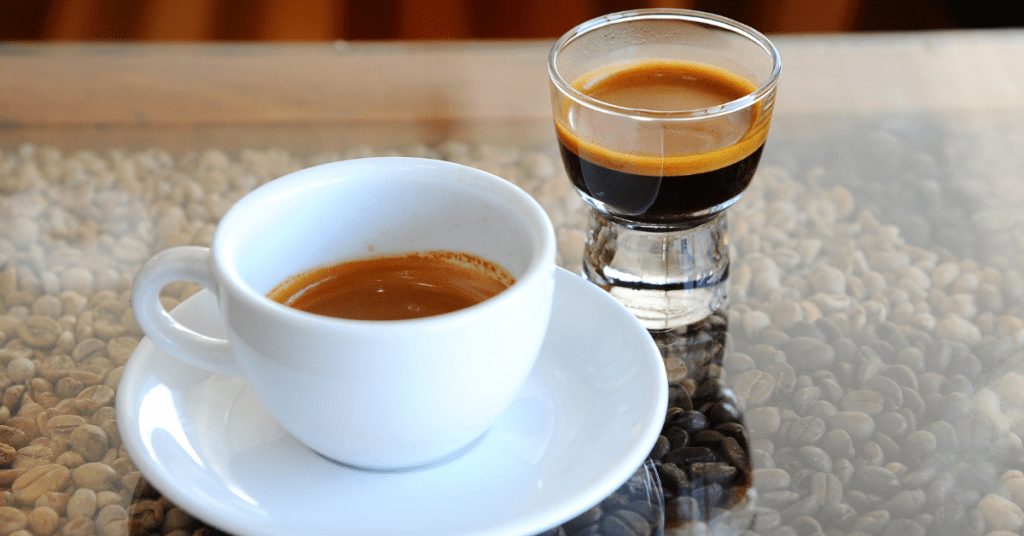If you like coffee without frills or additions, chances are you’re a fan of espresso.
But there are many ways to brew espresso. Ristretto and long shots are two of the variations on traditional espressos.
In this article, I’ll break down a ristretto vs long shot and walk you through each one.
Then I’ll give you a rundown of how they stack up against each other.
Let’s get to it!
What is a Ristretto

A ristretto shot is a short shot of espresso. In Italian, “ristretto” means “restricted.”
The idea is that you restrict how much hot water goes through the coffee by shortening the brew time.
Generally, a traditional espresso is about 2oz of coffee. A ristretto should be 1.5-1.75oz. The result is a shot of espresso that is a little sweeter, smoother, and less bitter than standard espresso.
While that’s a good guideline, ristrettos are more accurately defined by their ratio.
If a regular espresso coffee has a brew ratio of 1:2.5-3 grinds to espresso, then ristretto has a ratio of about 1:1.
For example, you can brew a double ristretto by using 14-16 grams of ground coffee and extracting around 30 grams of coffee.
You might order a ristretto if you want an espresso drink that has a ton of flavor packed into a couple of sips. Drinks that have a lower ratio of coffee to milk tend to work best with ristrettos. Cortados and traditional cappuccinos are my favorites to have with ristretto shots.
How to Make a Ristretto
There are three main ways of making a ristretto espresso.
The first (more traditional) method involves grinding the coffee finer than for a regular espresso shot. This makes it harder for hot water to pass through the coffee and results in less water actually making it into the cup.
Another way to achieve the same result is to simply tamp much harder than normal while keeping the grind size the same. This is common in cafes that don’t want to change their grind size.
The third (less preferred) way of making ristretto is by simply removing the cup before the espresso is finished.
Once the espresso is about 1.5oz, replace the cup with another and let the espresso finish pulling. The first part is now a ristretto.
This last method is common in busy cafes and for automatic machines.
What is a Long Shot

A long shot, or “lungo,” is a shot of espresso that is longer than normal.
If a ristretto shot is a little more than half of the espresso, then an espresso lungo is about double that of an espresso.
You might think that a long shot is just a doppio or double shot, but it is a little different.
Long shots can also be defined by their ratio.
A long shot should have a ratio of about 1:3-3.5. If you use 14 grams of ground coffee, then you should extract about 45 grams of espresso. That will give you a nice long shot.
The bitter taste of coffee gets extracted later in the brewing process. So, an espresso lungo will taste more bitter and subdued than regular espresso or ristretto.
The trick is making sure you don’t over-extract the coffee and turn the taste too bitter or tarry. You can make sure this doesn’t happen by grinding coarser than usual.
How to Make a Long Shot
Many semi- and super-automatic espresso machines have a pre-programmed setting for long shots. If you have an espresso machine with a long shot preset, simply choose that and enjoy.
If you have a manual espresso machine, don’t worry, it’s still easy to make a long shot.
Grind the same amount of beans a touch coarser than you would for a normal shot. Grinding the coffee bean slightly coarser decreases the resistance of hot water through the coffee. A coarser grind allows more water to get through to the cup.
Tamp your grinds the same as for espresso.
Here’s the difference: run your shot for about double the time it would take for a regular espresso. So if you pull espresso shots between 25-30 seconds, pull a long shot between 40-45 seconds.
That’s a loose guide. You’ll have to play around with your parameters and try out your long shots to figure out the best settings for your taste.
Ristretto vs Long Shot: The Difference
Ristrettos and long shots are both variations on a traditional espresso. On the surface, they look pretty similar. They can both be added to milk drinks to change the overall taste and texture of lattes or cappuccinos.
The size is the main difference when looking at a ristretto and a long shot. A ristretto will be 1-1.5oz and a long shot 2.5-4oz.
Once you taste them, however, you’ll notice just how different they are.
Taste

The taste between a ristretto and a long shot is as different as a vanilla latte and a cortado.
Because you’re restricting the extraction while brewing ristretto, you cut off the part of extraction that tastes bitter. The end result is an espresso that has a nice balance of acidity and sweetness without the bitterness often attributed to espresso.
On the other hand, long shots go beyond traditional espresso extraction and focus on the bitter extraction at the end.
While this might not sound appealing because you’re using more water to brew a long shot, it actually tastes really pleasant.
A long shot fills a gap in a cafe’s menus between an Americano and espresso. If you enjoy Americanos but sometimes think they can be a little watered down, chances are you’ll enjoy a long shot.
The extra water subdues some of the acidity you’d find in ristretto and espresso. The end result is an espresso that is nicely balanced between bitter and smooth.
Strength
Ristrettos and long shots are both espresso, so they’ll share similar strengths.
Both will be stronger than brewed coffee. Both will have crema that goes nicely with milk. And both will have good mouthfeel and balance.
The difference in strength depends on what you’re looking for from the espresso variants.
A ristretto will be more acidic and punchy, like lemonade or an orange slice. It will also have more body, like maple syrup or fudge sauce.
An espresso lungo will be heavier and more chocolatey, like red wine or a bar of dark chocolate. It will have a more watery texture, like black tea.
Generally, ristrettos are considered to be stronger than long shots. That’s because ristrettos pack all their flavor into a condensed single shot. Each sip will have a ton of flavor and complexity.
However, espresso lungo will have more caffeine due to the longer extraction.
Brewing Process

From the outside, it can be hard to tell if a barista is brewing a regular espresso, a ristretto, or a long shot.
Both ristrettos and long shots share a lot of steps in the brewing process. They are both pulled like regular espresso. Each one is a variation on espresso, after all.
The differences in the brewing process, however, are what separates them as drinks.
In a ristretto, coffee is ground finer than normal and sometimes tamped harder. This prevents hot water from going through the ground coffee and makes it harder for the coffee to extract for as long as a normal shot.
In long shots, coffee is ground a touch more coarse than usual but tamped the same as regular espresso. Grinding coarser allows more hot water to get through the coffee and into the cup.
FAQ
You might still have some questions about ristrettos and long shots. I answered a couple of the most common questions I get about the two.
Which espresso is the strongest?
A ristretto coffee will pack more of a punch. Ristrettos have a fuller body and a syrupy texture than espressos or long shots.
Long shots will be slightly more watery, have a subdued taste, and have a little bit more caffeine compared to ristretto, because of higher extraction.
Are ristretto shots less acidic?
A ristretto shot will taste more acidic than a long shot. That’s because you don’t use as much water to extract the coffee.
Coffee extracts sour flavors first, then sweet flavors, and finally bitter ones. Ristrettos restrict how much of the bitter flavor gets extracted, giving you a bright, packed ristretto.
Final Thoughts
There you have it, a rundown of ristretto vs long shot.
Ristrettos are shorter than regular espresso. They pack a ton of flavor into a smaller coffee drink. You’ll find a syrupy texture and a nice balance between acidity and sweetness.
Long shots are bigger than regular espresso. They mellow out the strength of espresso shots and have a smooth and drinkable texture with mellow flavors.
If you are a coffee lover, try them both in your favorite coffee shop to see just how different and delicious they can be!
Decided on making a ristretto shot at home? Check out our guide on making ristretto with both automatic and manual machines.










